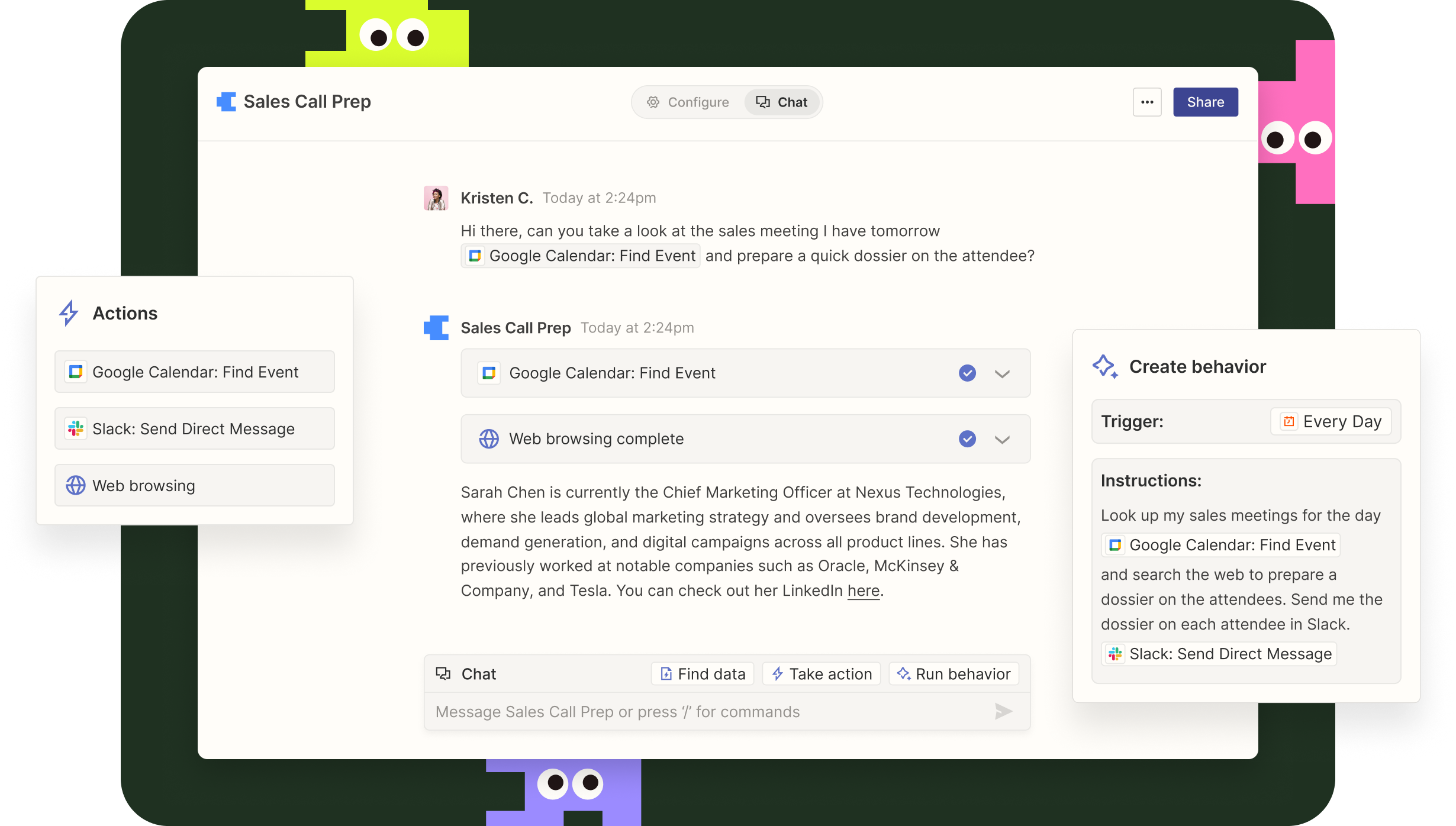That’s where AI agents come in.
While chatbots like ChatGPT respond to individual prompts, AI agents are designed to act on your behalf – carrying out multi-step tasks, using your tools, and even making decisions based on context. In this article, we’ll explore what AI agents are, how they work, and how small businesses can use them in practical, time-saving ways. Along the way, we’ll focus on Zapier’s AI agents, a leading example of the technology in action.
From chatbot to agent: What’s the difference?
The AI assistant you already know – like ChatGPT or Copilot – responds to a single prompt at a time. You ask for a product description or an email reply, and it generates it. It’s a powerful interaction, but it usually ends there unless you continue the conversation manually.
AI agents take things further. They’re designed to:
- Understand a goal (not just a question)
- Break that goal into steps
- Take actions using apps, APIs, or workflows
- Adjust their behavior based on context or feedback
Think of an agent less like a chatbot and more like a virtual team member. You give it a task, and it figures out how to get it done – sometimes using other tools or automations in the background.
How Zapier AI agents work

Here’s how it works:
You give the Zapier AI agent a clear objective in natural language – for example:
“Send a welcome email to new customers and add them to my CRM.”
The agent then:
1. Interprets your request.
2. Connects to your apps (e.g., Gmail, your CRM, your calendar).
3. Decides what actions are needed.
4. Executes them automatically – no need to build a Zap manually.
Zapier lets you create multiple agents with different responsibilities. For example, one agent can handle lead follow-up, another can manage calendar bookings, and another can summarize form responses and email you a report.
It’s not just a smarter chatbot – it’s a digital coworker that gets things done using your favorite tools.
Practical use cases for small businesses
The true power of AI agents is in the repetitive, high-friction tasks that eat up time every day. Here are a few ways small businesses can use them right now:
Automated customer onboarding
An agent can monitor new signups, send a personalized welcome email, add customer details to your CRM, and schedule a follow-up reminder – all without human input.
Internal reporting
If you collect data through forms or spreadsheets, an agent can generate a summary every Friday and send it to your team in Slack or email. No more digging through rows of data.
Lead nurturing
When a new lead fills out a form on your site, an agent can check their industry, send the right intro message, tag them based on priority, and notify your sales team instantly.
Content updates
Running events or launching products? An AI agent can update event listings across platforms, generate a social media post, and notify your email list – without jumping between tabs.
These are the kinds of tasks that usually require multiple tools, some manual effort, and too much time. With agents, they become background processes.
What makes Zapier’s approach useful?
Unlike some experimental AI agent tools that require programming skills or custom setups, Zapier’s AI agents are built with non-technical users in mind. The platform offers:
- Natural language prompts: No code or complex logic needed.
- Access to thousands of apps: Through Zapier’s integrations, your agent can work across nearly any tool you already use.
- Modular workflows: You can tweak, test, and adjust how the agent works without starting from scratch.
- Scalability: As your needs grow, your agents can handle more tasks without extra cost or complexity.
You’re not limited to just asking questions – you’re giving your tools the ability to act intelligently, based on what you want to achieve.
Are AI agents ready for everyday use?
AI agents are still a developing space. They don’t always get things right on the first try, and some tasks still benefit from human review. But for clearly defined, repeatable processes, they’re already proving valuable – especially for small teams that want to do more with less.
What’s important is to treat AI agents not as a magic solution, but as a partner in automation. You set the rules. You guide the outcomes. And with the right setup, they save hours each week by doing the heavy lifting in the background.
Final thoughts: Should you try it?
If you’re already using automation tools or AI assistants in your business, experimenting with AI agents is a natural next step. Tools like Zapier make it surprisingly accessible – no technical skills required.
And while the concept might sound futuristic, the results are very real: faster processes, fewer mistakes, and more time to focus on growth.
Ready to explore what AI agents can do?
You’ll find Zapier and other automation-friendly tools in Aimie’s AI Tool Directory.
 Aimie
Aimie